Gas plant in Newburgh tests limits of NY’s landmark climate law
Can New York meet its emissions goals if it green-lights more fossil fuel infrastructure? A proposal to rebuild a fracked-gas plant will set the precedent.
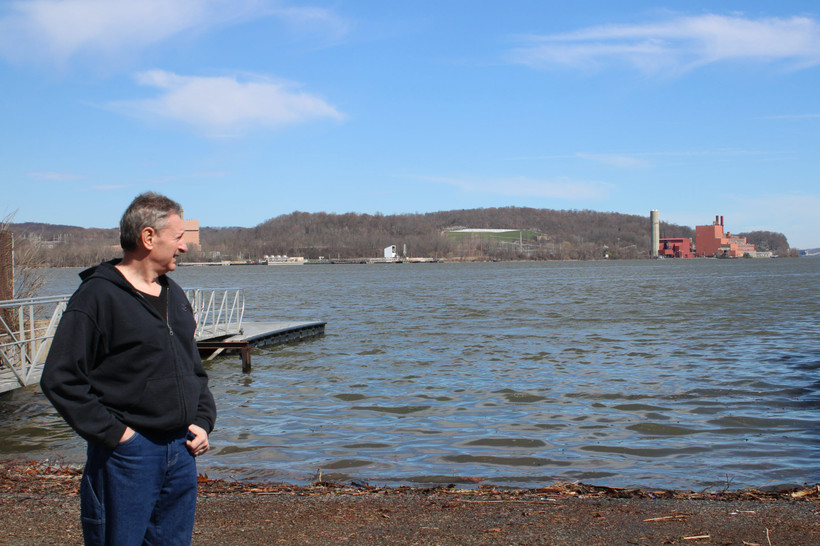
This story was published in partnership with City & State New York.
In the late 19th century, Newburgh in the Hudson Valley represented the bleeding edge of industrial technology. Streams powering wool, gunpowder, flour and saw mills emptied into the Hudson River, where steamships carried industrial cargo. Thomas Edison in 1884 selected Newburgh to host one of the world’s first central power stations, making it the second electrified municipality in the United States after lower Manhattan.
A century later, Newburgh’s economic leadership had stalled, as manufacturers relocated and the river lost shipping traffic to trucking. The city of 28,000 now has the highest poverty rate downstate, and Newburgh’s mostly Latino and Black population struggles with high crime, water safety crises and rates of asthma more than twice the statewide average.
Newburgh has intermittently been visited by revitalization efforts. Then-first lady Hillary Clinton toured the city’s Dutch Reformed Church in 1998 as part of a campaign to preserve historic architecture. The church’s ceiling later collapsed. A banner reading “Save America’s Treasures” still hangs in front.
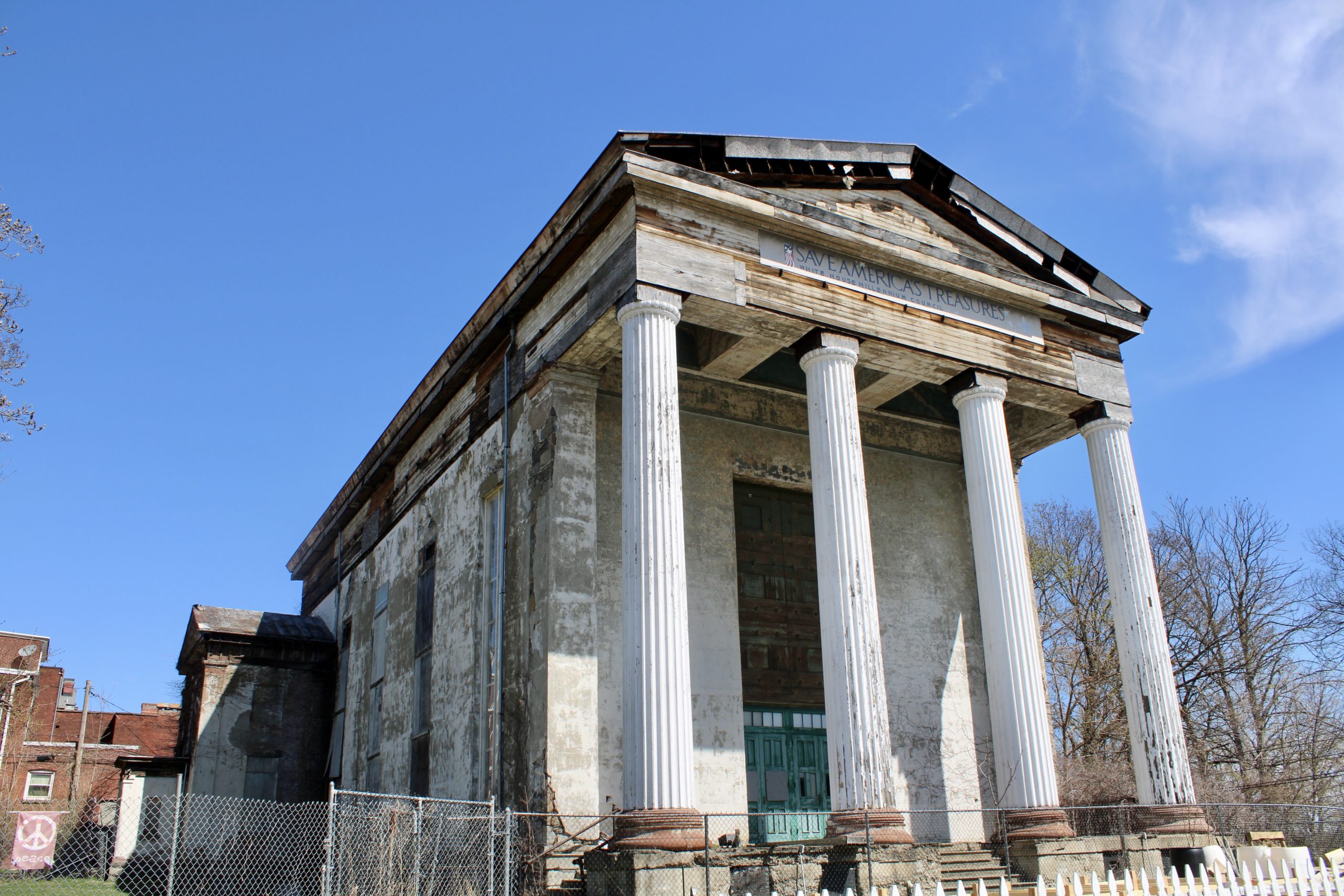 Newburgh’s Dutch Reformed Church. A 1998 banner from the “Save America’s Treasures” tour, led by then-First Lady Hillary Clinton, still hangs outside. Photo: Lee Harris
Newburgh’s Dutch Reformed Church. A 1998 banner from the “Save America’s Treasures” tour, led by then-First Lady Hillary Clinton, still hangs outside. Photo: Lee HarrisNow, new energy production has been proposed in Newburgh, but it is drawing opposition from environmentalists. A natural gas-fired power plant applied for state approval to shutter its current aging facility and rebuild higher up on the bank of the Hudson as a brand-new plant.
The Danskammer power plant rebuild is the first proposal for a large-scale fracked-gas facility to be considered under the Climate Leadership and Community Protection Act, Gov. Andrew Cuomo’s signature climate legislation, which aims to cut greenhouse gas emissions by 85% from 1990 levels by 2050.
The application is the first test of how the Public Service Commission’s Siting Board deals with proposed fossil fuel infrastructure under that landmark law, passed in 2019.
“If it is rejected on climate grounds, it will mean basically this will be the last application for a gas plant in New York state, because if this one can’t meet the requirements now, every year that goes by, it gets harder,” said Richard Webster, legal director for Riverkeeper, a nonprofit group that works on water issues in the Hudson River.
Two other downstate fossil fuel plants – NRG in Astoria, Queens, and Eastern Generation in Gowanus, Brooklyn – are also currently seeking state approval.
Climate advocates say the state should be decommissioning fossil fuel plants rather than approving new ones. Danskammer proponents argue that natural gas is cleaner than coal, and a new plant will be an improvement over the older, less-efficient plants, like neighboring Roseton Generating Station, also in Newburgh.
In March, hundreds of activists spoke at public hearings held by the Siting Board. Only a small minority supported granting Danskammer’s permit.
“When the state misses those goals, nothing functionally happens.”
Originally coal-fired, Danskammer was repowered to run on gas after being damaged in Superstorm Sandy. The facility now operates as a “peaker plant,” revving up only a few days per year when electricity demand surges, typically on the hottest summer days.
The proposed new plant would continue to burn natural gas delivered through a pipeline. (New York banned fracking in 2015, but still imports gas, including fracked gas, from states like Pennsylvania.) As a relatively more efficient baseload plant, the new facility would be called upon by the grid to operate more frequently – humming away as much as 60-70% of the time, according to Michelle Hook, Danskammer’s vice president of public relations.
Though it emits less carbon dioxide and conventional pollutants than coal or oil, burned gas still creates climate pollution. Methane released in the extraction, transport and combustion of natural gas is also an especially potent greenhouse gas. One 2017 study of three gas-fired power plants found that the facilities were releasing more than 20 times more methane than their self-reported estimates.
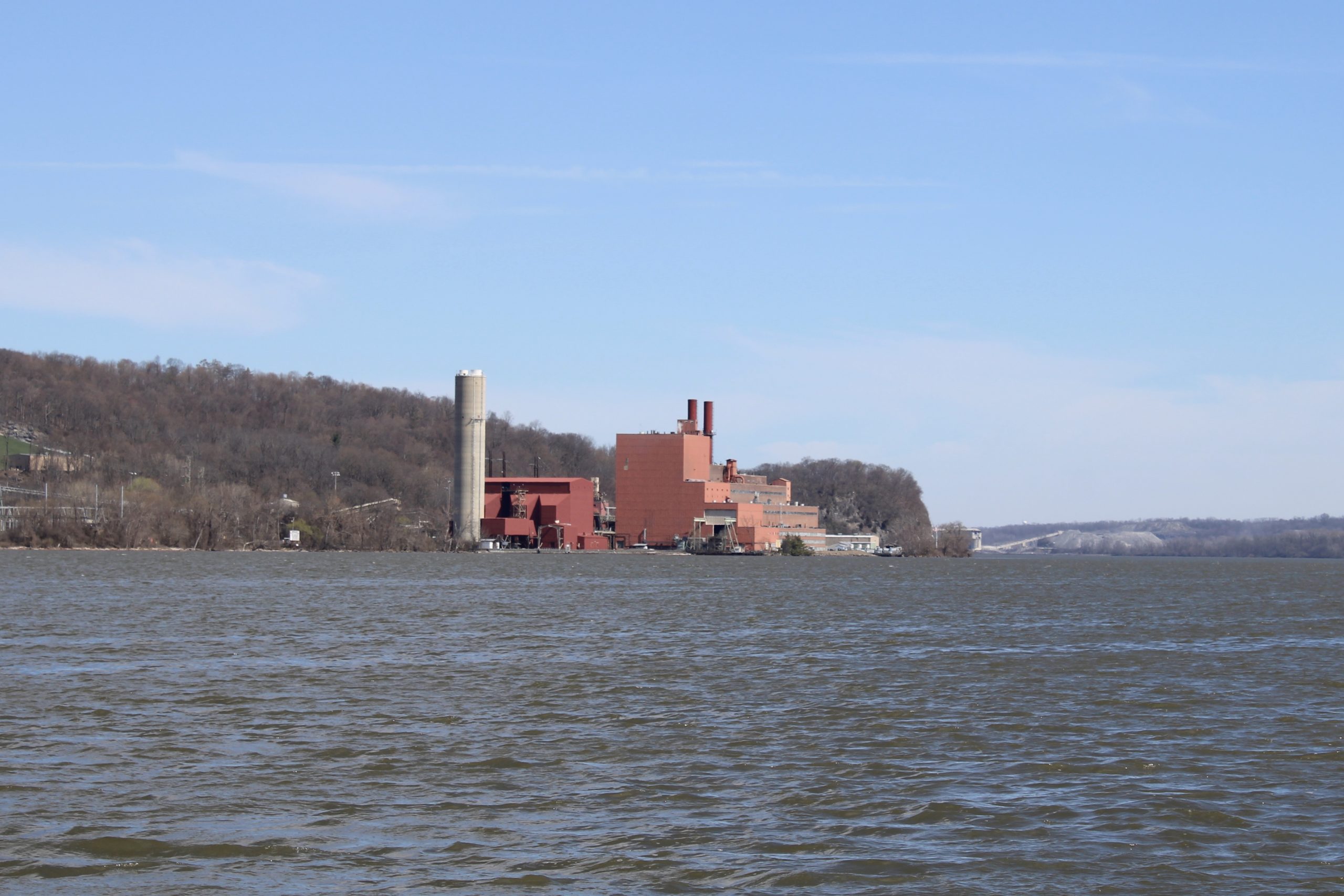 Danskammer plant. Photo: Lee Harris
Danskammer plant. Photo: Lee HarrisThe Danskammer proposal comes as Indian Point, a nuclear power plant in the nearby town of Buchanan in Westchester County, was set to close by April 30, leaving the state more heavily reliant on burning fossil fuels.
“When you take a zero-emissions generator as large as Indian Point offline, and you don’t have zero-emissions power generation to replace it, emissions are going to go up,” Hook said. “You can either get that power from a cleaner source, like a new, upgraded Danskammer, with all of the new emissions controls that are required on new plants – just like when new cars roll off the assembly line, they have much more emissions controls than a 1970 Buick – or, you can use the old facilities.”
Environmental advocates point to a study by New York Independent System Operator, a nonprofit corporation that operates the state grid, that found there were no immediate reliability concerns for the state’s electricity demand if the new Danskammer facility wasn’t built.
But proponents of natural gas say the continued use of fossil fuels will be a necessary part of the transition to green energy. Eventually, studies have found, the state will need to build on-demand capacity that can run during lulls of wind and solar, as those energy sources become a greater share of New York’s energy mix.
Danskammer’s filings to the Siting Board say that the plant would increase emissions of carbon dioxide in New York state. However, it says, carbon dioxide emissions would decline in the Northeast region overall because the new Danskammer plant would be called upon to run more frequently, displacing older, dirtier sources of power.
Danskammer opponents say that analysis fails to take into account renewable projects currently underway. Also, climate activists say, building new fossil fuel infrastructure could have long-lasting “lock-in” effects.
“While we have climate goals enshrined into law, if and when the state misses those goals, nothing functionally happens. And so every new piece of fossil fuel infrastructure you build runs the risk of locking you into a scenario where you miss those goals,” said Alex Beauchamp, Northeast region director at Food & Water Watch.
Alternatives to fracked gas
Across the Hudson River from Newburgh, in the hamlet of Chelsea, Lou Cicigline, a retired state corrections sergeant, is also concerned about the planned construction. Cicigline moved to Chelsea from New York City 20 years ago, hoping to spend more time in nature.
“Throughout the years of living here, when that plant did run once in a while, you seen all that smoke coming out, (when) the wind direction is coming this way,” he said. For most of the time Cicigline has lived in the Hudson Valley, Danskammer burned coal.
“That stuff’s coming right into my house,” he recalled thinking. Cicigline has recently had problems with breathing, he said, and he has been seeing his doctor to try to determine the cause. He wonders whether air quality played a role.
 Lou Cicigline worries about the climate-heating effects of fracking. Photo: Lee Harris
Lou Cicigline worries about the climate-heating effects of fracking. Photo: Lee HarrisCicigline also worries about the climate-heating effects of fracking, and about nitrogen oxides, which are produced at low levels by the burning of natural gas – though significantly less than by burning coal – and can worsen smog and contribute to respiratory problems.
In filings, Danskammer has suggested that it could convert the plant to run on green hydrogen or renewable natural gas after 2040 – provided New York determines those experimental fuels count as zero emissions.
Environmentalists note that these fuels are currently unproven, prohibitively expensive and raise their own climate concerns. Most commercially available hydrogen is produced using fossil fuels, while a tiny percentage of the hydrogen supply consists of green hydrogen, which is produced through electrolysis.
Renewable natural gas is drawn from landfills or manure in industrial agriculture, rather than drilled. Some green groups are enthusiastic about renewable natural gas, but others, such as Food & Water Watch, say increasing demand for it would incentivize the expansion of environmentally harmful factory farming.
If the transition to renewable natural gas or another source couldn’t be made to fit within the Climate Leadership and Community Protection Act, Hook said, the plant would simply shut down.
According to the legislation, all electricity generation must be carbon-free by 2040. But the law has few interim milestones, aside from a goal of 70% renewable by 2030. And no individual plant faces a hard stop in 2030.
“Probably, Danskammer is looking at the fact that other than the 2040 date, there are no other hard dates for gas plants to have to stop operating. And I think that’s where they see their opening,” said Hayley Carlock, director of environmental advocacy and legal affairs for Scenic Hudson, a regional environmental organization.
The state’s Climate Action Council, a 22-member panel tasked with charting the course for carrying out the Climate Leadership and Community Protection Act, has gotten off to a slow start, according to members. “Having some clear written, enforceable guidance or requirements would just make things easier,” Carlock said.
Schools and property tax
Aura Lopez Zarate, a community organizer with a focus on reproductive justice, enjoys kayaking in the Hudson and walking her dog by the shore.
“If I was to have a family here in five or 10 years, I want my children to have clean air, clean water, a clean environment – like we all do. How can I do that when there’s a plant pumping chemicals into our air?” the 24-year-old said.
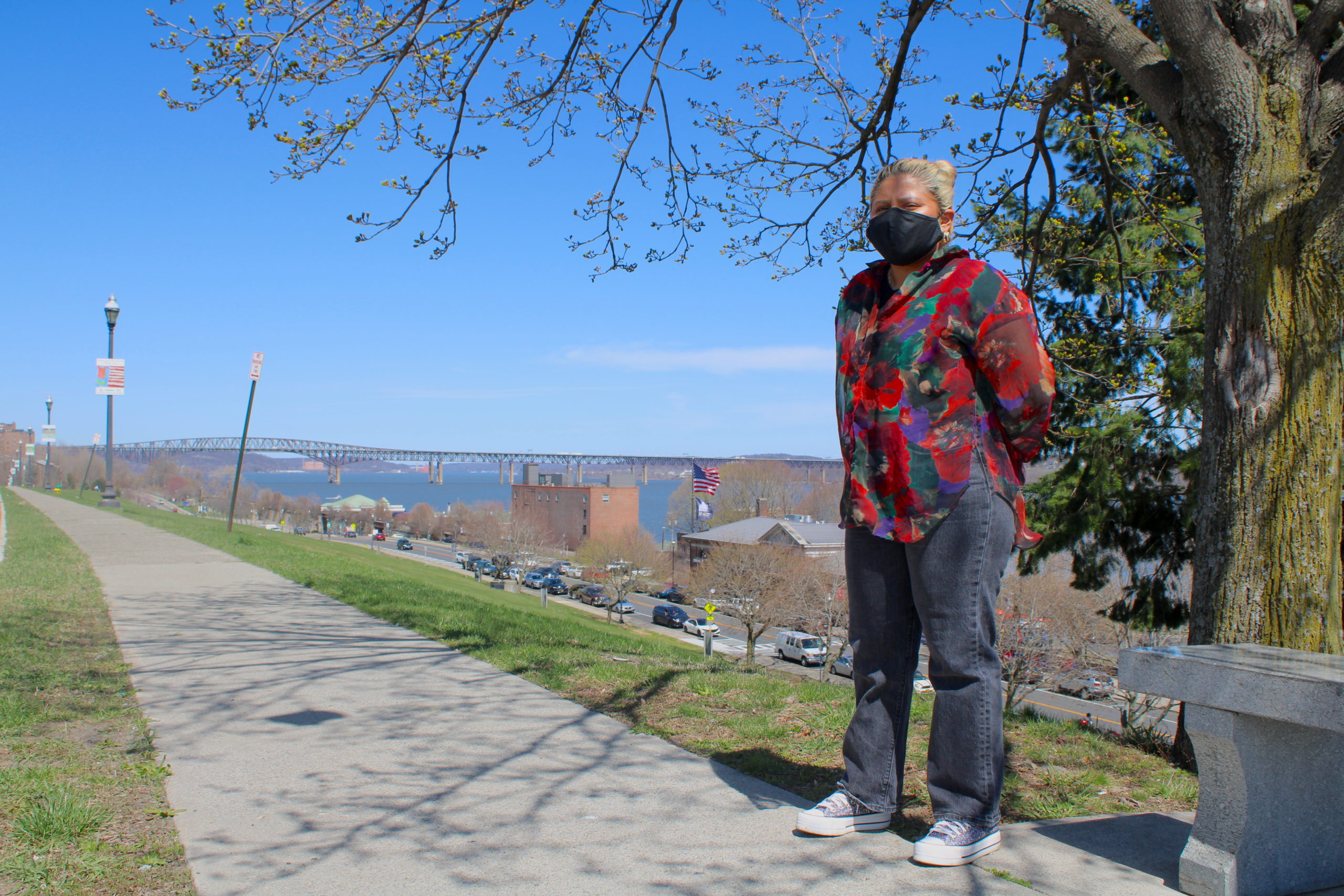 Aura Lopez Zarate, a community organizer in Newburgh, stands by the Hudson River, where she enjoys kayaking. Danskammer plant is visible on the shore, left of center. Photo: Lee Harris
Aura Lopez Zarate, a community organizer in Newburgh, stands by the Hudson River, where she enjoys kayaking. Danskammer plant is visible on the shore, left of center. Photo: Lee HarrisActivists like Lopez Zarate have been disappointed by state elected officials’ refusal to weigh in on Danskammer. While at least 20 municipalities around the Hudson Valley, including Newburgh and Beacon, have passed resolutions opposing the expansion, state legislators have held back.
Newburgh’s state Sen. James Skoufis, a Democrat, has been largely silent on the issue, with the exception of a town hall in 2019, in which he warned that getting rid of Danskammer could spell “financial calamity” for Marlboro Central School District.
Part of the town of Newburgh, where the plant sits, falls within the Marlboro school district. As a result, the Danskammer plant and the neighboring Roseton plant are a major part of the tax base for the neighboring town of Marlborough.
That school district mostly serves Marlborough, which is 93% white and has more than twice the median household income of Newburgh.
“To know we have this tax base for the next 20 years will help Marlborough families,” Town Supervisor Alphonso Lanzetta said at the hearing last month.
Environmental experts say local taxes are often a roadblock to decommissioning fossil fuel infrastructure. One way to avoid local holdouts might be to regionalize the tax base for public education.
“We’re going to have to make sure that as these fossil fuel plants start to close, we have to address the local tax issue, because otherwise, potentially, school taxes are going to take a real hit,” said Jen Metzger, the former Democratic state senator from Ulster and Orange counties who helped design the Climate Leadership and Community Protection Act and proposed legislation, which never passed, that aimed to halt the construction of new fossil fuel infrastructure.
An advisory panel to the Climate Action Council plans to recommend that New York declare a moratorium on new natural gas facilities, potentially thwarting Danskammer’s proposed repowering. Meanwhile, legislation sponsored by state Sen. Jabari Brisport, a Democrat from Brooklyn, would halt permitting for peaker plants until they submit plans to switch to battery storage and renewables within five years. That bill recently passed the state Senate, but has not yet been brought to a vote in the Assembly.
Brisport said applications like Danskammer’s likely wouldn’t be subject to that legislation. “This is the first plant that I’m hearing is trying to convert from peaker to base load. That sounds like a loophole that we overlooked when constructing the bill,” he said in an interview. “It makes me wonder if we should go back and try and strengthen the bill now, to avoid situations like this.”
Skoufis voted against Brisport’s bill to stop peaker plant permitting. When he spoke to Skoufis about the bill, Brisport said, the senator from Orange County cited concerns that the bill could “cause a domino effect with the loss of property tax.”
“I disagreed, mostly because it wasn’t a bill to make them close down – it was primarily to help them transition,” Brisport said. “You’re getting property tax on the property whether it’s a gas-fired plant, or it’s a plant running renewable energy and battery storage.”
Skoufis could not be made available for an interview for this article. A spokesperson didn’t respond to Brisport’s description of their exchange.
Even as pressure builds to ban fossil fuel buildouts, the governor has resisted calls to quash new gas construction. “If you say as an absolute, well you can't build any more natural gas plants, then the question arises: What happens if you don’t have enough renewables online?” Cuomo said at a press conference on April 19. “I’m hopeful that we do. But what if you don’t?”
Low-carbon work for Newburgh
Danskammer supporters at the hearings were drawn heavily from the building trades, which anticipate temporary construction work on the new facility.
Todd Diorio, business manager of Laborers’ Local 17, has publicly cautioned against the “bad faith” and “scare tactics” of Danskammer’s critics.
Danskammer says the plant would not bring new permanent jobs, but would keep employment on par with the roughly 45 workers employed at the current facility.
Workers like Mark Sanchez-Potter, a substitute teacher who has led organizing efforts against the plant, agree that Newburgh needs job opportunities, but say the decision between environmental priorities and hard-hat jobs is a false choice. Rather than fossil fuel infrastructure, Sanchez-Potter would rather see the area invest in “low-carbon work” – jobs in sectors like nursing, teaching and domestic care.
Others, such as Metzger, suggest rebuilding Danskammer as a battery storage facility. In 2019, plans for a hybrid natural gas and battery facility in nearby Ulster County were dropped following residents’ and activists’ objections in favor of a utility-scale battery plant.
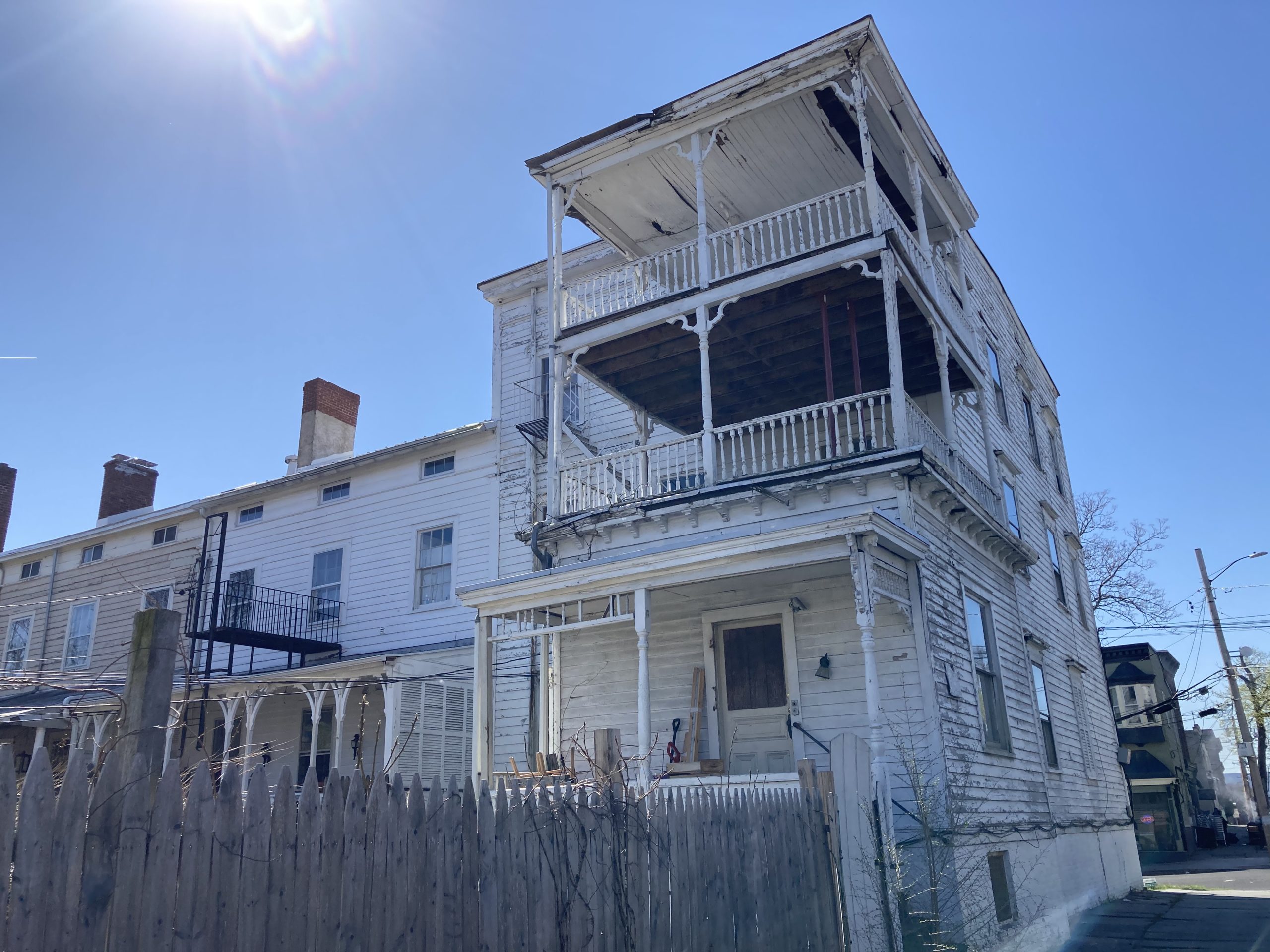 A city block in Newburgh. The city has endured several partial attempts at economic revitalization. Photo: Lee Harris
A city block in Newburgh. The city has endured several partial attempts at economic revitalization. Photo: Lee HarrisIn the meantime, there are signs of new commercial development in Newburgh. In 2019, Hudson Taco opened in a former train station that had fallen into disrepair. Now, the restaurant is partnering with a local brewery that opened in 2012.
Not all development is welcome, however. Lopez Zarate worries the area may fall prey to gentrification, and richer arrivals could displace current inhabitants.
Still, the restaurant could help with Newburgh’s revitalization, the owner told Hudson Valley Magazine. “This is going to be an eclectic Mexican eatery as opposed to a taqueria.”




